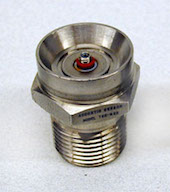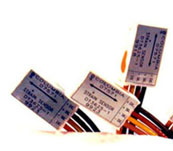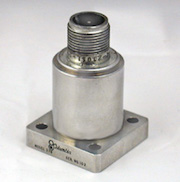Vibration Monitors are designed for military and commercial helicopters
Series 961/960-TX sensors monitor vibration generated by military and commercial helicopter engines, transmissions, and airframes.
» Read MoreCompact & Miniature Force Balance Accelerometers
Airborne applications SA-102BHC / SA-302BHC compact and SA-102MFTB / SA-302MFTA miniature precision accelerometers operate from +24 to +32 VDC aircraft power.
» Read MoreNew Sensor Designed to Measure Strain on Curved Mounting Surfaces
Accuracy, ruggedness, and ease of installation found in Columbia's flight-qualified Series DTD284, DT3747 models compensate materials commonly used in aircraft structural fabrication.
» Read MoreMeasurements In Low Frequency Micro-G Range
High sensitivity, ultra low noise use in seismic, low level, low frequency motion studies. SA-107LN is a single axis unit and SA-207LN, and SA-307LN are two and three axis units.
» Read MoreApplications
Columbia manufactures a wide range of sensors and associated signal conditioning electronics that can be used in a variety of applications. Our product line includes force balance inertial-grade accelerometers and inclinometers, piezoelectric vibration and pressure sensors, strain gage aircraft mainframe fatigue sensors, precision linear variable differential transducers, and fiber optic sensors. Columbia sensors have been installed in military aircraft, in-flight missile systems, and/or interplanetary manned and unmanned space vehicles. Our sensors are used extensively in industrial control and monitoring systems. Columbia also supplies operational sensors used to measure vibration, acceleration, temperature, and strain for a host of applications.
▶
Monitor Vibration of Helicopter Engines, Transmissions, Airframes Sensors Qualified on Navy VTS Program
 The Columbia 961 and 960-TX are designed to monitor vibration generated by Military and Commercial helicopter engines, transmissions and airframes. The single axis 961 incorporates an integral two conductor shielded cable and is available with an optional top mount 10-32 connector. This sophisticated diagnostic system also senses rotor imbalances. The rugged miniature sealed case design with integral strain relieved cable, replaceable mounting stud and safety wire drilled body adapts to confined aircraft mounting locations. The triaxial 960-TX has three miniature mutually perpendicular vibration sensors mounted into a rugged machined housing which incorporates a single central mounting screw. The model 961 and each sensor in the 960-TX features integrated thick film electronic signal conditioning circuitry which provides high sensitivity, temperature compensation and low impedance output drive capability. These sensor configurations are ideally suited to other vibration monitoring applications such as aircraft modal and structural analysis, shipboard engine vibration monitoring, commercial machinery vibration monitoring and as the primary vibration sensor for all predictive maintenance vibration diagnostics systems.
The Columbia 961 and 960-TX are designed to monitor vibration generated by Military and Commercial helicopter engines, transmissions and airframes. The single axis 961 incorporates an integral two conductor shielded cable and is available with an optional top mount 10-32 connector. This sophisticated diagnostic system also senses rotor imbalances. The rugged miniature sealed case design with integral strain relieved cable, replaceable mounting stud and safety wire drilled body adapts to confined aircraft mounting locations. The triaxial 960-TX has three miniature mutually perpendicular vibration sensors mounted into a rugged machined housing which incorporates a single central mounting screw. The model 961 and each sensor in the 960-TX features integrated thick film electronic signal conditioning circuitry which provides high sensitivity, temperature compensation and low impedance output drive capability. These sensor configurations are ideally suited to other vibration monitoring applications such as aircraft modal and structural analysis, shipboard engine vibration monitoring, commercial machinery vibration monitoring and as the primary vibration sensor for all predictive maintenance vibration diagnostics systems.
▶
Airborne / Flight Qualified Sensors
 Airborne Accelerometers are designed to operate from a single power supply of +24 to +32VDC, typical aircraft power supply. They are also designed with a high degree of power supply regulation in order to isolate the output from power supply variations experienced in the aircraft. Columbia Research Labs offers three accelerometers that were specifically designed to run from this aircraft power.
Airborne Accelerometers are designed to operate from a single power supply of +24 to +32VDC, typical aircraft power supply. They are also designed with a high degree of power supply regulation in order to isolate the output from power supply variations experienced in the aircraft. Columbia Research Labs offers three accelerometers that were specifically designed to run from this aircraft power.
The single axis SA-102BHC and triaxial SA-302BHC are premium performance force balance accelerometers. Their rugged construction makes them well suited for demanding missile and airborne applications. The basic systems have been qualified and supplied in substantial volume on many small missile programs. These designs have also been selected by a number of aircraft instrument manufactures as key components of their strap-down systems. The miniature single axis SA-102MFTB is an excellent candidate for airborne telemetry applications. The output signal format is compatible with most airborne VCO's and signal processing systems. All three of these models incorporate the Columbia HP torquer system, which provides exceptional performance an reliability in severe vibration and shock environments associated with aircraft and missile flights.
In addition to accelerometers Columbia Research Labs manufactures a flight qualified fatigue monitor strain sensor. Series DTD2684 was developed for the demanding requirements associated with tactical military aircraft. They provide an accurate representation of the fatigue loading experienced by tactical aircraft under various conditions of speed, weight and mission configuration. Critical areas, such as under carriage structures and control surfaces may be more accurately monitored for potential fatigue damage induced by high-g maneuvers and high stress landings.
▶
Gas Turbines / Models 765M25 and 765M27
 Columbia's Models 765M25 and 765M27 high intensity acoustic sensors are designed for the measurement of gas-borne sound in industrial applications. They have a high sensitivity of 1200pC/psi, a high temperature range to 500°F, they are electrically isolated and are constructed for use in corrosive environments. A chose of electrical interface is available. A balanced and floating compressed figuration is provided for enhanced rejection of electrical noise. These dynamic pressure sensors are used extensively in gas turbines.
Columbia's Models 765M25 and 765M27 high intensity acoustic sensors are designed for the measurement of gas-borne sound in industrial applications. They have a high sensitivity of 1200pC/psi, a high temperature range to 500°F, they are electrically isolated and are constructed for use in corrosive environments. A chose of electrical interface is available. A balanced and floating compressed figuration is provided for enhanced rejection of electrical noise. These dynamic pressure sensors are used extensively in gas turbines.
▶
Aircraft / Model DTD2684
 Columbia's flight qualified, pre-wired integral full bridge, self temperature compensating foil sensors obtain reliable strain measurements on critical aircraft frames, wings and under carriage structures for potential fatigue damage caused by thousands of flight hours and have been used extensively on the U.S. F-18 aircraft for over 20 years. These fatigue load monitoring foil strain sensors also feature high accuracy, high output-two active arms, ease of installation, rugged construction and are environmental resistant.
Columbia's flight qualified, pre-wired integral full bridge, self temperature compensating foil sensors obtain reliable strain measurements on critical aircraft frames, wings and under carriage structures for potential fatigue damage caused by thousands of flight hours and have been used extensively on the U.S. F-18 aircraft for over 20 years. These fatigue load monitoring foil strain sensors also feature high accuracy, high output-two active arms, ease of installation, rugged construction and are environmental resistant.
▶
Turbine / Model 387
 Columbia's model 378 piezoelectric accelerometer offers very high sensitivity for remote turbine engine monitoring, control and automatic shutdown. The model 378HT accelerometer is a precision manufactured accelerometer designed for measurement of shock and vibration of structures subject to very high temperatures. Model 378 has a sensitivity of 1050 pC/g, frequency range of 1Hz to 2KHz, and a shock limit of 1000(g). The 378HP has a sensitivity of 55pC/g and a frequency range of 2Hz-2KHz.
Columbia's model 378 piezoelectric accelerometer offers very high sensitivity for remote turbine engine monitoring, control and automatic shutdown. The model 378HT accelerometer is a precision manufactured accelerometer designed for measurement of shock and vibration of structures subject to very high temperatures. Model 378 has a sensitivity of 1050 pC/g, frequency range of 1Hz to 2KHz, and a shock limit of 1000(g). The 378HP has a sensitivity of 55pC/g and a frequency range of 2Hz-2KHz.

 Accelerometers
Accelerometers Dynamic Pressure Sensors
Dynamic Pressure Sensors Fiber Optic Pressure Seals
Fiber Optic Pressure Seals Force Balance Inclinometers
Force Balance Inclinometers L.V.D.T. Products
L.V.D.T. Products Portable Vibration Meters
Portable Vibration Meters Signal Conditioning Instruments
Signal Conditioning Instruments Strain Sensors
Strain Sensors Vibration/Temp. Transmitters
Vibration/Temp. Transmitters
